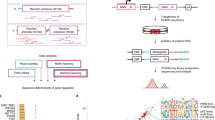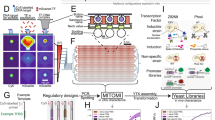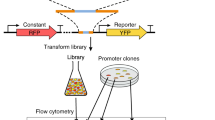Abstract
Gene expression is regulated in part by protein transcription factors that bind target regulatory DNA sequences. Predicting DNA binding sites and affinities from transcription factor sequence or structure is difficult; therefore, experimental data are required to link transcription factors to target sequences. We present a microfluidics-based approach for de novo discovery and quantitative biophysical characterization of DNA target sequences. We validated our technique by measuring sequence preferences for 28 Saccharomyces cerevisiae transcription factors with a variety of DNA-binding domains, including several that have proven difficult to study by other techniques. For each transcription factor, we measured relative binding affinities to oligonucleotides covering all possible 8-bp DNA sequences to create a comprehensive map of sequence preferences; for four transcription factors, we also determined absolute affinities. We expect that these data and future use of this technique will provide information essential for understanding transcription factor specificity, improving identification of regulatory sites and reconstructing regulatory interactions.
This is a preview of subscription content, access via your institution
Access options
Subscribe to this journal
Receive 12 print issues and online access
$209.00 per year
only $17.42 per issue
Buy this article
- Purchase on Springer Link
- Instant access to full article PDF
Prices may be subject to local taxes which are calculated during checkout



Similar content being viewed by others
Accession codes
References
Tanay, A. Extensive low-affinity transcriptional interactions in the yeast genome. Genome Res. 16, 962–972 (2006).
Segal, E., Raveh-Sadka, T., Schroeder, M., Unnerstall, U. & Gaul, U. Predicting expression patterns from regulatory sequence in Drosophila segmentation. Nature 451, 535–540 (2008).
Badis, G. et al. Diversity and complexity in DNA recognition by transcription factors. Science 324, 1720–1723 (2009).
Kim, H.D. & O′Shea, E.K. A quantitative model of transcription factor-activated gene expression. Nat. Struct. Mol. Biol. 15, 1192–1198 (2008).
Segal, E. & Widom, J. From DNA sequence to transcriptional behavior: a quantitative approach. Nat. Rev. Genet. 10, 443–456 (2009).
Gertz, J., Siggia, E.D. & Cohen, B.A. Analysis of combinatorial cis-regulation in synthetic and genomic promoters. Nature 457, 215–218 (2009).
Yuh, C.H., Bolouri, H. & Davidson, E.H. Cis-regulatory logic in the endo16 gene: switching from a specification to a differentiation mode of control. Development 128, 617–629 (2001).
Iyer, V.R. et al. Genomic binding sites of the yeast cell-cycle transcription factors SBF and MBF. Nature 409, 533–538 (2001).
Johnson, D.S., Mortazavi, A., Myers, R.M. & Wold, B. Genome-wide mapping of in vivo protein-DNA interactions. Science 316, 1497–1502 (2007).
Garner, M.M. & Revzin, A. A gel electrophoresis method for quantifying the binding of proteins to specific DNA regions: application to components of the Escherichia coli lactose operon regulatory system. Nucleic Acids Res. 9, 3047–3060 (1981).
Galas, D.J. & Schmitz, A. DNAse footprinting: a simple method for the detection of protein-DNA binding specificity. Nucleic Acids Res. 5, 3157–3170 (1978).
Jost, J.P., Munch, O. & Andersson, T. Study of protein-DNA interactions by surface plasmon resonance (real time kinetics). Nucleic Acids Res. 19, 2788 (1991).
Meng, X., Brodsky, M.H. & Wolfe, S.A. A bacterial one-hybrid system for determining the DNA-binding specificity of transcription factors. Nat. Biotechnol. 23, 988–994 (2005).
Badis, G. et al. A library of yeast transcription factor motifs reveals a widespread function for Rsc3 in targeting nucleosome exclusion at promoters. Mol. Cell 32, 878–887 (2008).
Zhu, C. et al. High-resolution DNA-binding specificity analysis of yeast transcription factors. Genome Res. 19, 556–566 (2009).
Berger, M.F. et al. Compact, universal DNA microarrays to comprehensively determine transcription-factor binding site specificities. Nat. Biotechnol. 24, 1429–1435 (2006).
Berger, M. et al. Variation in homeodomain DNA binding revealed by high-resolution analysis of sequence preferences. Cell 133, 1266–1276 (2008).
De Silva, E.K. et al. Specific DNA-binding by apicomplexan AP2 transcription factors. Proc. Natl. Acad. Sci. USA 105, 8393–8398 (2008).
Bonham, A.J., Neumann, T., Tirrell, M. & Reich, N.O. Tracking transcription factor complexes on DNA using total internal reflectance fluorescence protein binding microarrays. Nucleic Acids Res. 37, 94 (2009).
Maerkl, S.J. & Quake, S.R. A systems approach to measuring the binding energy landscapes of transcription factors. Science 315, 233–237 (2007).
Ralston, A. De Bruijn sequences-a model example of the interaction of discrete mathematics and computer science. Math. Mag. 55, 131–143 (1982).
Harbison, C.T. et al. Transcriptional regulatory code of a eukaryotic genome. Nature 431, 99–104 (2004).
Foat, B.C., Morozov, A.V. & Bussemaker, H.J. Statistical mechanical modeling of genome-wide transcription factor occupancy data by MatrixREDUCE. Bioinformatics 22, e141–e149 (2006).
Wu, R., Chaivorapol, C., Zheng, J., Li, H. & Liang, S. fREDUCE: detection of degenerate regulatory elements using correlation with expression. BMC Bioinformatics 8, 399 (2007).
Vogel, K., Horz, W. & Hinnen, A. The two positively acting regulatory proteins PHO2 and PHO4 physically interact with PHO5 upstream activation regions. Mol. Cell. Biol. 9, 2050–2057 (1989).
Wieland, G. et al. Determination of the binding constants of the centromere protein Cbf1 to all 16 centromere DNAs of Saccharomyces cerevisiae. Nucleic Acids Res. 29, 1054–1060 (2001).
Liu, Y. et al. A suite of web-based programs to search for transcriptional regulatory motifs. Nucleic Acids Res. 32, W204–W207 (2004).
Bailey, T.L. et al. MEME SUITE: tools for motif discovery and searching. Nucleic Acids Res. 37, W202–W208 (2009).
Pavesi, G. et al. MoD Tools: regulatory motif discovery in nucleotide sequences from co-regulated or homologous genes. Nucleic Acids Res. 34, W566–W570 (2006).
Pachkov, M., Erb, I., Molina, N. & Van Nimwegen, E. SwissRegulon: a database of genome-wide annotations of regulatory sites. Nucleic Acids Res. 35, D127–D131 (2007).
Acknowledgements
P.M.F. was supported by a Howard Hughes Medical Institute/Helen Hay Whitney Foundation Postdoctoral Fellowship. J.L.D., S.R.Q. and this work were supported by the Howard Hughes Medical Institute. We thank A. Potanina for assistance with fabrication of microfluidic devices, O. Homann for implementation of PSAM functionality with MochiView and D. Breslow, F. Caro, S. Churchman, M. Dimon, T. Kiers, A. Kistler, C. Nelson, K. Sorber, E. Yeh and I. Zuleta for careful reading of the manuscript.
Author information
Authors and Affiliations
Contributions
P.M.F. designed experiments, designed, created and printed the DNA library, made linear expression templates, fabricated microfluidic devices, performed microfluidic experiments assessing concentration-dependent binding and binding to the 8-mer library, analyzed data and wrote the manuscript. D.G. designed experiments, designed and fabricated microfluidic devices and performed microfluidic experiments assessing binding to the 8-mer library. D.T. fabricated microfluidic devices and performed microfluidic experiments assessing binding to the 8-mer library. J.Z. and H.L. analyzed data. S.R.Q. designed experiments, analyzed data and wrote the manuscript. J.L.D. designed experiments, assisted with printing the DNA library, analyzed data and wrote the manuscript.
Corresponding authors
Ethics declarations
Competing interests
The authors declare no competing financial interests.
Supplementary information
Supplementary Text and Figures
Supplementary Tables 1–8, Supplementary Figs. 1–19 and Supplementary Methods (PDF 4961 kb)
Rights and permissions
About this article
Cite this article
Fordyce, P., Gerber, D., Tran, D. et al. De novo identification and biophysical characterization of transcription-factor binding sites with microfluidic affinity analysis. Nat Biotechnol 28, 970–975 (2010). https://doi.org/10.1038/nbt.1675
Received:
Accepted:
Published:
Issue Date:
DOI: https://doi.org/10.1038/nbt.1675
This article is cited by
-
KaScape: a sequencing-based method for global characterization of protein‒DNA binding affinity
Scientific Reports (2023)
-
Systematic analysis of low-affinity transcription factor binding site clusters in vitro and in vivo establishes their functional relevance
Nature Communications (2022)
-
Precursor biosynthesis regulation of lignin, suberin and cutin
Protoplasma (2021)
-
Design of orthogonal regulatory systems for modulating gene expression in plants
Nature Chemical Biology (2020)
-
The Role of Cross-Pathway Control Regulator CpcA in the Growth and Extracellular Enzyme Production of Penicillium oxalicum
Current Microbiology (2020)




